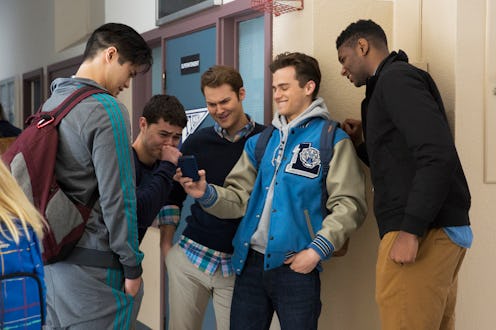Entertainment
'13 Reasons Why' Shows The Deadly Consequences Of Rape Culture

Navigating the halls of a new high school is overwhelming for many people, but Hannah Baker faces a far too common problem when she transfers to a new school. She longs for a clean slate, but one photo and the betrayal of her crush set off a chain of events that culminate in her tragic suicide. The depiction of rape culture on Netflix's 13 Reasons Why shows the painful impact on victims — and all the ways people shrug their shoulders and say "boys will be boys." This article contains spoilers for 13 Reasons Why, up to and including the finale.
One of the most important aspects of 13 Reasons Why is its depiction of the many forms that rape culture takes: a rumor that people eagerly devour, a list that declares whether girls are "hot or not," groping a teen in public. All of these incidents contribute to an environment that sends the message that men are entitled to women's bodies. As the Netflix series shows, every single act of degradation has a devastating impact on Hannah and causes her to fall into deeper despair. And, the fact that the perpetrators face no consequences undoubtedly emboldens people like Bryce to escalate to committing rape.
By the end of the series, Bryce has brutally raped both Jessica and Hannah. To be clear, he alone is responsible for his cruel, criminal actions and the school's rape culture is not an excuse in any way, shape, or form. But it's so important to note that these attacks don't simply occur in a vacuum — both girls attend a school where they're objectified and degraded as a matter of course, and these acts of aggression are dismissed by staff and students alike. It's no surprise that Bryce assumes he'll get away with raping both girls.
Recently, a guy mansplained to me that far fewer women are victimized than reports from sexual violence organizations like RAINN indicate. He claimed that such statistics include account "minor" forms of assault and that most women won't experience rape. First of all, in 2010 the CDC found that one in five women have been raped, which it classified as "completed forced penetration, attempted forced penetration, or alcohol/drug facilitated completed penetration," so the statistics are staggeringly high even within that specific definition.
But second — and most importantly — people need to recognize that all forms of sexual assault and harassment are traumatic, instead of brushing some aside.
Hannah, who is already emotionally vulnerable, is initially ecstatic to share her first kiss with her crush, Justin, but he immediately betrays her trust by circulating a compromising photo that people are all too eager to misinterpret so they can label her the "class slut." It's high school, so things quickly escalate — a "hot or not list" circulates, and Hannah is declared to have the "best ass" in school.
The list further emphasizes the notion that girls and women exist purely to satisfy the male gaze — and it subjects her to further harassment. In the public space of a store, Hannah is approached by a classmate who grabs her butt without her consent. To be clear, this is a form of sexual assault.
As defined by the United States Department of Justice, sexual assault includes "sexual activities as forced sexual intercourse, forcible sodomy, child molestation, incest, fondling, and attempted rape." It's crucial for everyone (both teens and adults) to have a clear understanding of what falls under the umbrella of sexual assault. All these incidents need to be taken seriously and treated as the crimes they are. It's impossible to confront rape culture if we don't acknowledge that each and every incident matters and contributes to this toxic mindset.
After Bryce gets away with raping Jessica and sexually harassing Hannah, he's further emboldened. Although Hannah has already begun to contemplate suicide, the final straw is when she's raped by Bryce at a party. With no friends left, she hopes the school's counselor will offer her a lifeline — but Mr. Porter fails her too.
Rather than referring her to a sexual violence specialist, he tells Hannah that if she won't identify her attacker, which she is clearly afraid to do, the best tactic is to simply "move on." Rape culture isn't just perpetuated by the school's students — the staff is also complicit.
It would be easy to dismiss Hannah's suicide as a dramatic plot device — but it's heartbreakingly realistic. So often, friends, adults, and the legal system fail rape victims and leave them feeling alone, trapped, and ashamed. The rape culture epidemic is deadly — especially in high school, where victims are forced to see their attackers smirk at them on a daily basis and they risk being ostracized if they dare utter a word about the rape.
As depicted in the Netflix documentary Audrie & Daisy, suicide attempts are not an anomaly amongst high school rape victims. Fifteen-year-old Audrie Potts hung herself after photos of her sexual assault were circulated by classmates, and two young women interviewed in the documentary, Delaney Henderson and Daisy Coleman, both attempted suicide multiple times after being assaulted and then bullied when they spoke up about it. And according to the National Center for PTSD, it's estimated that one in three women who have been raped contemplate suicide, and one in 10 victims attempt it.
13 Reasons Why is undeniably painful to watch, and that's exactly why it's such important TV for both teens and adults. Instead of dismissing a "hot or not" list or a rumor as no big deal, we need to consider the environment this creates. Once we acknowledge the magnitude of the problem, we're better positioned to confront and prevent it.